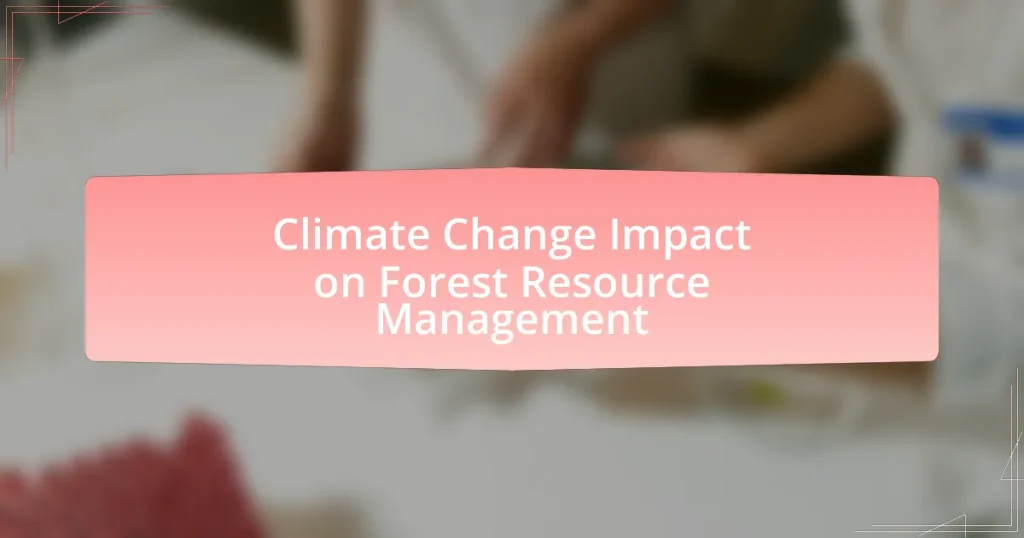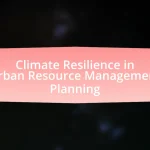The article examines the significant impact of climate change on forest resource management, highlighting how alterations in temperature and precipitation patterns disrupt forest ecosystems, biodiversity, and resource availability. It discusses the economic implications of these changes, including reduced timber yields and increased management costs, while emphasizing the necessity for adaptive management strategies to enhance forest resilience. Key topics include the role of forests in carbon sequestration, the challenges posed by invasive species, and the importance of sustainable forestry practices and policies in mitigating climate impacts. The article also explores how technology, such as remote sensing and data analytics, can aid in effective forest management under changing climate conditions.
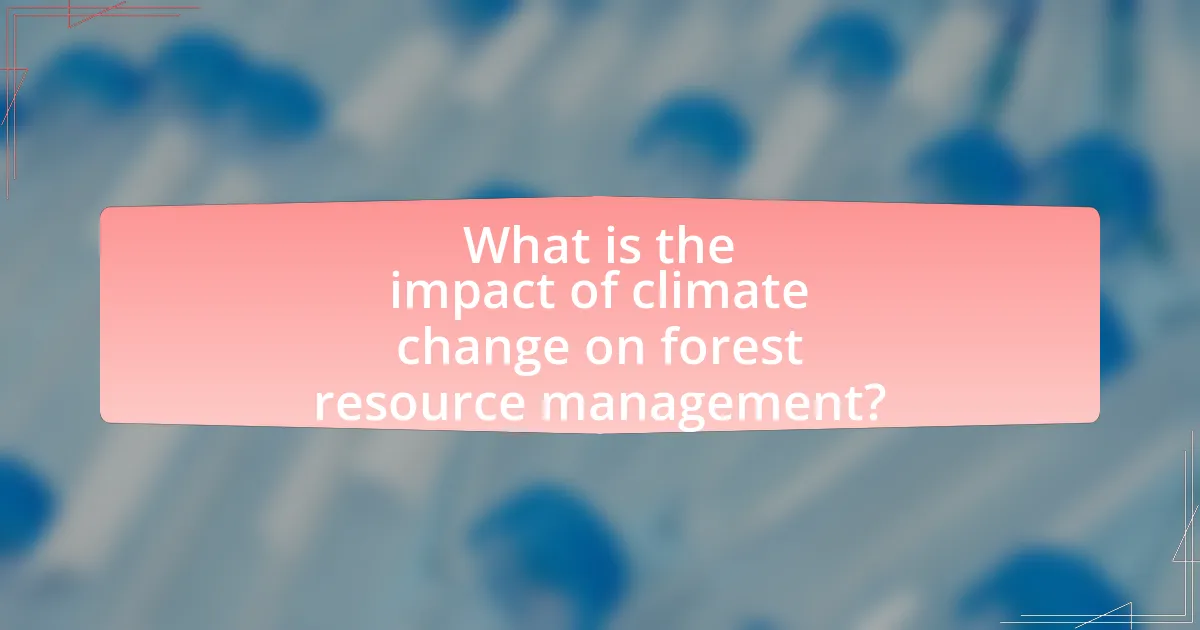
What is the impact of climate change on forest resource management?
Climate change significantly impacts forest resource management by altering forest ecosystems, affecting biodiversity, and changing the availability of forest resources. Increased temperatures and altered precipitation patterns lead to shifts in species distribution, which can disrupt existing forest management practices. For instance, studies indicate that climate change can increase the frequency and intensity of forest fires, pests, and diseases, further complicating management efforts. According to the Intergovernmental Panel on Climate Change (IPCC), these changes necessitate adaptive management strategies to maintain forest health and productivity, highlighting the urgent need for integrating climate resilience into forest resource management plans.
How does climate change affect forest ecosystems?
Climate change significantly affects forest ecosystems by altering temperature and precipitation patterns, which can lead to shifts in species composition and forest health. For instance, increased temperatures can enhance the frequency and intensity of wildfires, as evidenced by the 2019-2020 Australian bushfires, which burned over 18 million hectares and devastated numerous forest habitats. Additionally, changing precipitation patterns can result in drought stress, impacting tree growth and increasing susceptibility to pests and diseases, as seen in the bark beetle outbreaks in North American forests. These changes disrupt the ecological balance, affecting biodiversity and the services forests provide, such as carbon sequestration and habitat for wildlife.
What are the primary changes in temperature and precipitation patterns?
The primary changes in temperature and precipitation patterns include an increase in average global temperatures and alterations in precipitation distribution. Average global temperatures have risen by approximately 1.2 degrees Celsius since the late 19th century, primarily due to human activities such as fossil fuel combustion and deforestation. Precipitation patterns are becoming more erratic, with some regions experiencing increased rainfall and others facing prolonged droughts. For instance, the Intergovernmental Panel on Climate Change (IPCC) reports that heavy precipitation events have increased in frequency and intensity, while areas like the Mediterranean and parts of Africa are experiencing significant decreases in rainfall. These changes impact ecosystems and forest resource management by altering species distributions, growth rates, and forest health.
How do these changes influence forest biodiversity?
Changes in climate significantly influence forest biodiversity by altering species distribution, ecosystem dynamics, and habitat availability. For instance, rising temperatures and shifting precipitation patterns can lead to the migration of tree species to higher altitudes or latitudes, which disrupts existing ecosystems and can result in the loss of native species. A study published in “Nature Climate Change” by Thomas et al. (2012) found that approximately 30% of species are at an increased risk of extinction due to climate change impacts on their habitats. Additionally, changes in forest composition can affect the interactions between species, leading to altered food webs and ecosystem services. These dynamics underscore the critical relationship between climate change and forest biodiversity, highlighting the need for adaptive management strategies in forest resource management.
What are the economic implications of climate change on forest resources?
Climate change significantly impacts forest resources economically by altering timber yields, increasing management costs, and affecting ecosystem services. For instance, rising temperatures and changing precipitation patterns can lead to reduced growth rates and increased vulnerability to pests and diseases, which in turn can decrease timber supply and quality. A study by the Intergovernmental Panel on Climate Change (IPCC) indicates that forest productivity could decline by up to 20% in some regions by 2100 due to climate-related stresses. Additionally, increased frequency of extreme weather events, such as wildfires and storms, raises the costs of forest management and restoration, further straining economic resources. These factors collectively threaten the livelihoods of communities dependent on forestry, reduce revenue from timber sales, and diminish the overall economic value of forest ecosystems.
How does climate change affect timber production and forest products?
Climate change negatively impacts timber production and forest products by altering growth patterns, increasing pest infestations, and affecting forest health. Rising temperatures and changing precipitation patterns can lead to reduced tree growth rates and increased mortality, as evidenced by studies showing that warmer climates can stress trees, making them more susceptible to diseases and pests. For instance, the U.S. Forest Service reports that climate change has already contributed to significant tree die-offs in various regions, which directly affects the availability of timber. Additionally, extreme weather events, such as droughts and storms, can damage forests, further reducing timber supply and impacting the quality of forest products.
What are the costs associated with adapting forest management practices?
The costs associated with adapting forest management practices include financial investments in new technologies, training for personnel, and potential loss of revenue during the transition period. Specifically, implementing sustainable practices may require purchasing advanced equipment or software for monitoring and managing forest health, which can range from thousands to millions of dollars depending on the scale of operations. Additionally, training staff to effectively use these new practices incurs costs related to education and time away from regular duties. Research indicates that transitioning to adaptive management can lead to short-term revenue losses, as traditional practices may be less productive during the adaptation phase. For example, a study by the Food and Agriculture Organization highlights that initial costs can be significant, but long-term benefits include increased resilience to climate change and improved forest health, ultimately offsetting these initial expenses.
What role do forests play in mitigating climate change?
Forests play a crucial role in mitigating climate change by acting as significant carbon sinks, absorbing approximately 2.6 billion metric tons of carbon dioxide annually. This process helps to reduce the concentration of greenhouse gases in the atmosphere, thereby slowing global warming. Additionally, forests contribute to climate regulation by influencing local and regional weather patterns, maintaining biodiversity, and providing ecosystem services that enhance resilience against climate impacts. The Intergovernmental Panel on Climate Change (IPCC) reports that sustainable forest management can enhance carbon storage and reduce emissions from deforestation, further underscoring the importance of forests in climate change mitigation strategies.
How do forests contribute to carbon sequestration?
Forests contribute to carbon sequestration by absorbing carbon dioxide from the atmosphere during the process of photosynthesis. Through this process, trees convert carbon dioxide into organic matter, which is stored in their biomass, including trunks, branches, leaves, and roots. According to the Intergovernmental Panel on Climate Change (IPCC), forests globally sequester approximately 2.6 billion metric tons of carbon dioxide annually, significantly mitigating climate change effects. This ability to store carbon makes forests essential in reducing atmospheric carbon levels and combating global warming.
What are the potential consequences of forest loss on climate change?
Forest loss significantly exacerbates climate change by increasing greenhouse gas emissions and reducing carbon sequestration. When forests are cleared or degraded, the carbon stored in trees is released into the atmosphere, contributing to higher levels of carbon dioxide, a major greenhouse gas. According to the Food and Agriculture Organization, deforestation accounts for approximately 10-15% of global greenhouse gas emissions. Additionally, the loss of forests diminishes the Earth’s capacity to absorb carbon dioxide, as trees play a crucial role in capturing and storing carbon. This dual impact of increased emissions and decreased carbon uptake accelerates global warming and disrupts climate patterns, leading to more extreme weather events and altering ecosystems.
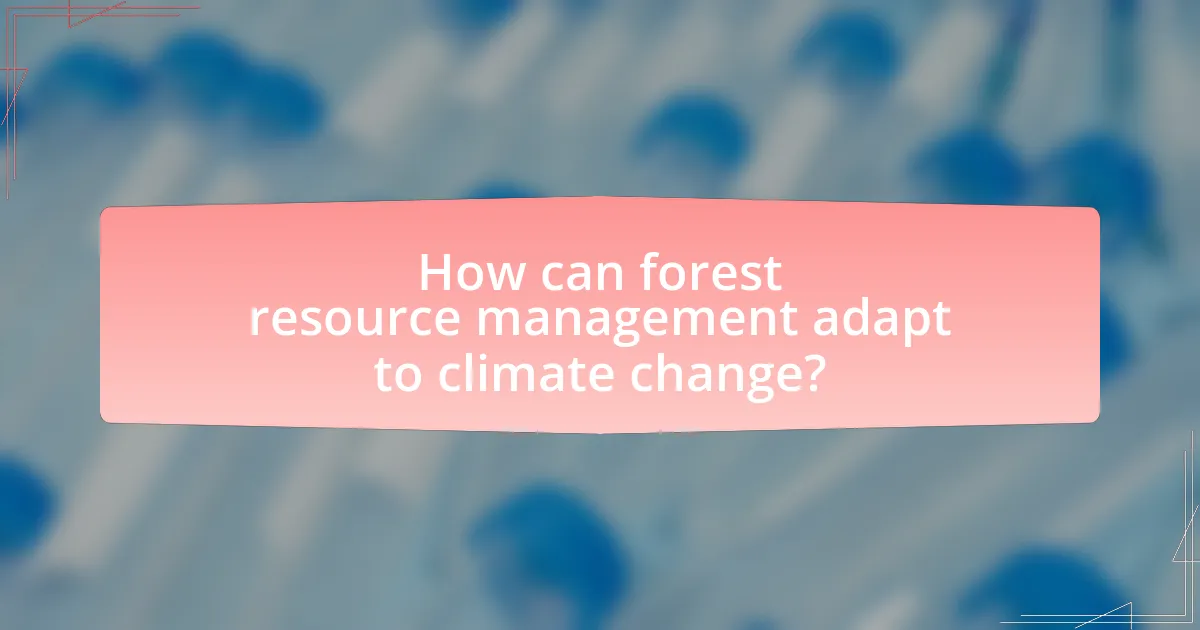
How can forest resource management adapt to climate change?
Forest resource management can adapt to climate change by implementing adaptive management practices that enhance resilience and sustainability. These practices include monitoring forest health, adjusting species composition to favor climate-resilient species, and employing controlled burns to reduce wildfire risks. Research indicates that forests managed with adaptive strategies can better withstand climate-related stressors, such as drought and pests, thereby maintaining ecosystem services. For instance, a study published in “Forest Ecology and Management” by Millar et al. (2007) emphasizes the importance of proactive management in promoting forest resilience to climate change impacts.
What strategies are effective for adapting forest management practices?
Effective strategies for adapting forest management practices include implementing adaptive management frameworks, enhancing biodiversity, and utilizing climate-smart forestry techniques. Adaptive management frameworks allow for continuous learning and adjustment based on changing environmental conditions, which is crucial in the context of climate change. Enhancing biodiversity helps to build ecosystem resilience, as diverse forests are better equipped to withstand pests, diseases, and extreme weather events. Climate-smart forestry techniques, such as selective logging and agroforestry, promote sustainable practices that align with climate adaptation goals. These strategies are supported by research indicating that forests managed with these approaches show improved resilience and productivity in the face of climate variability.
How can sustainable forestry practices mitigate climate impacts?
Sustainable forestry practices mitigate climate impacts by enhancing carbon sequestration, promoting biodiversity, and reducing greenhouse gas emissions. These practices, such as selective logging, reforestation, and maintaining forest health, allow forests to absorb more carbon dioxide from the atmosphere, thereby lowering overall carbon levels. For instance, a study published in “Nature Climate Change” by Pan et al. (2011) indicates that forests globally sequester approximately 2.6 billion metric tons of carbon annually. Additionally, sustainable practices help maintain diverse ecosystems, which are more resilient to climate change, further supporting carbon storage and reducing vulnerability to pests and diseases. By minimizing soil disturbance and avoiding clear-cutting, sustainable forestry also decreases emissions associated with land-use changes, contributing to a more stable climate.
What role does reforestation play in adaptation efforts?
Reforestation plays a crucial role in adaptation efforts by enhancing ecosystem resilience to climate change. It helps restore biodiversity, improves soil quality, and increases carbon sequestration, which mitigates the effects of climate change. For instance, a study published in “Nature” by Bastin et al. (2019) estimates that restoring 1 billion hectares of forest could capture up to 205 gigatons of carbon dioxide, significantly reducing atmospheric greenhouse gases. Additionally, reforestation can help regulate local climates, reduce the risk of floods, and improve water availability, thereby supporting communities in adapting to changing environmental conditions.
What policies can support climate-resilient forest management?
Policies that can support climate-resilient forest management include sustainable land-use planning, financial incentives for conservation, and regulations promoting biodiversity. Sustainable land-use planning ensures that forest areas are managed in a way that considers climate risks, thereby enhancing resilience. Financial incentives, such as payments for ecosystem services, encourage landowners to maintain forest cover and implement sustainable practices. Regulations that promote biodiversity, such as protecting native species and habitats, help forests adapt to changing climate conditions. These policies are supported by research indicating that diverse ecosystems are more resilient to climate impacts, as shown in studies by the Intergovernmental Panel on Climate Change, which highlight the importance of biodiversity in maintaining ecosystem functions under climate stress.
How can governments incentivize sustainable forest practices?
Governments can incentivize sustainable forest practices by implementing financial mechanisms such as subsidies, tax breaks, and grants for landowners who adopt eco-friendly methods. For instance, the U.S. government has established programs like the Conservation Reserve Program, which pays farmers to convert environmentally sensitive land into conservation reserves, thereby promoting sustainable land use. Additionally, governments can create certification systems that reward sustainable forestry practices, as seen in the Forest Stewardship Council certification, which encourages responsible management of forests. These approaches not only provide economic benefits to landowners but also contribute to the overall health of forest ecosystems, supporting biodiversity and carbon sequestration efforts.
What international agreements impact forest resource management in the context of climate change?
International agreements that impact forest resource management in the context of climate change include the Paris Agreement, the United Nations Framework Convention on Climate Change (UNFCCC), and the Convention on Biological Diversity (CBD). The Paris Agreement, adopted in 2015, aims to limit global warming and encourages countries to enhance their forest management practices to achieve carbon neutrality. The UNFCCC, established in 1992, provides a framework for international cooperation on climate change, emphasizing the importance of sustainable forest management as a means to mitigate climate impacts. The CBD, which focuses on biodiversity conservation, also recognizes the role of forests in maintaining ecological balance and combating climate change. These agreements collectively influence national policies and practices regarding forest conservation and sustainable management, thereby shaping global efforts to address climate change.
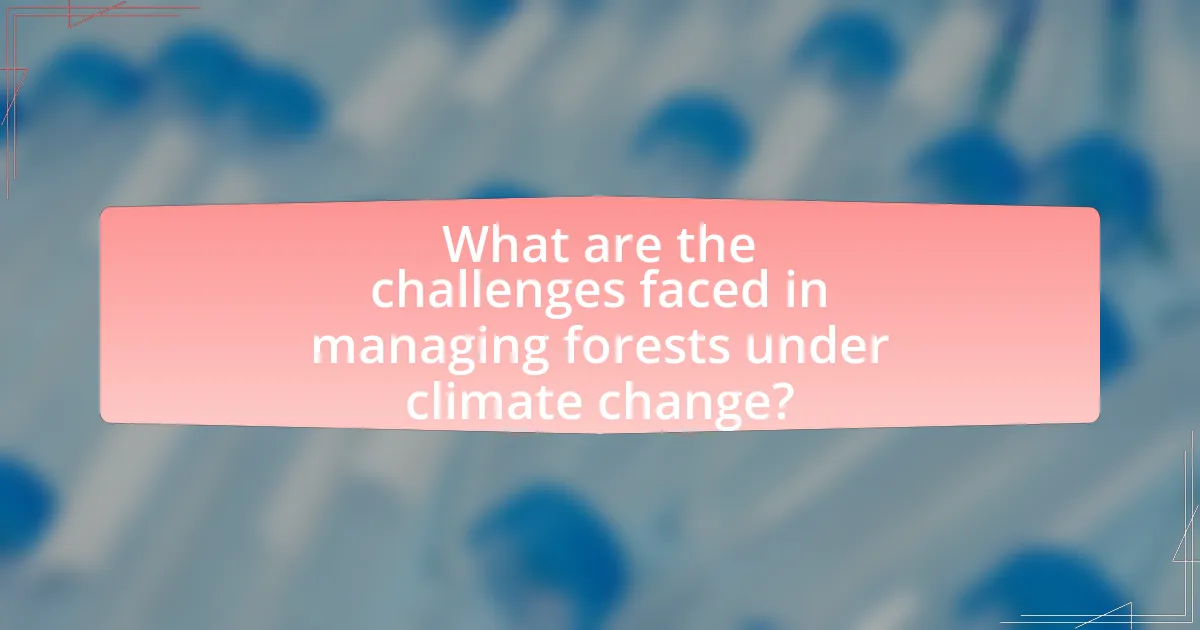
What are the challenges faced in managing forests under climate change?
The challenges faced in managing forests under climate change include increased frequency of extreme weather events, shifts in species distribution, and heightened pest and disease outbreaks. These factors complicate forest management strategies, as extreme weather can lead to forest degradation and loss of biodiversity. For instance, studies indicate that climate change has already altered the distribution of tree species, making it difficult for managers to predict which species will thrive in changing conditions. Additionally, the rise in pests and diseases, exacerbated by warmer temperatures, poses significant threats to forest health, requiring adaptive management practices to mitigate these risks effectively.
What are the main obstacles to effective forest management in a changing climate?
The main obstacles to effective forest management in a changing climate include increased frequency of extreme weather events, shifting species distributions, and heightened pest and disease pressures. Extreme weather events, such as droughts and storms, disrupt forest ecosystems and complicate management practices. Shifting species distributions due to temperature changes can lead to mismatches between species and their habitats, making it difficult to maintain biodiversity and ecosystem services. Additionally, the rise in pest and disease outbreaks, exacerbated by warmer temperatures, threatens forest health and resilience. These factors collectively hinder the ability to implement sustainable forest management strategies effectively.
How do invasive species impact forest health and management?
Invasive species significantly degrade forest health and complicate management efforts. They outcompete native flora for resources such as light, water, and nutrients, leading to reduced biodiversity and altered ecosystem functions. For instance, the introduction of the emerald ash borer has resulted in the decline of ash tree populations in North America, which disrupts habitat for various wildlife species and affects forest structure. Furthermore, invasive species can introduce diseases that native species are not equipped to handle, exacerbating their decline. Effective forest management must therefore include strategies for monitoring and controlling invasive species to maintain ecosystem integrity and resilience.
What challenges do forest managers face in predicting climate impacts?
Forest managers face significant challenges in predicting climate impacts due to the complexity of ecological systems and the variability of climate models. The unpredictability of weather patterns, such as temperature fluctuations and precipitation changes, complicates the ability to forecast forest health and growth. Additionally, the interactions between various species and their responses to climate stressors, such as pests and diseases, further complicate predictions. Research indicates that climate models often have limitations in spatial resolution and temporal accuracy, making it difficult for forest managers to apply these predictions effectively in local contexts. For instance, a study published in “Forest Ecology and Management” highlights that discrepancies in model outputs can lead to misinformed management decisions, ultimately affecting forest resilience and biodiversity.
How can technology assist in overcoming these challenges?
Technology can assist in overcoming challenges related to climate change impact on forest resource management by providing advanced data analytics and monitoring tools. These tools enable real-time tracking of forest health, growth patterns, and biodiversity through satellite imagery and remote sensing technologies. For instance, the use of Geographic Information Systems (GIS) allows forest managers to analyze spatial data, facilitating informed decision-making regarding resource allocation and conservation strategies. Additionally, predictive modeling software can forecast the effects of climate variables on forest ecosystems, helping to develop adaptive management plans. Research indicates that integrating these technologies can enhance resilience against climate change, as evidenced by a study published in “Forest Ecology and Management” which found that data-driven approaches improved forest management outcomes by 30% in regions facing climate stressors.
What role does remote sensing play in forest management?
Remote sensing plays a crucial role in forest management by providing accurate and timely data on forest conditions, health, and changes over time. This technology enables the monitoring of deforestation, forest degradation, and biomass estimation, which are essential for sustainable management practices. For instance, satellite imagery can detect changes in forest cover and assess the impact of climate change on forest ecosystems, allowing for informed decision-making. Studies have shown that remote sensing can improve forest inventory accuracy by up to 30%, enhancing resource management strategies and conservation efforts.
How can data analytics improve decision-making in forest resource management?
Data analytics can significantly enhance decision-making in forest resource management by providing actionable insights derived from large datasets. By analyzing satellite imagery, climate data, and biodiversity metrics, forest managers can identify trends such as deforestation rates, species distribution changes, and the impacts of climate change on forest health. For instance, a study published in the journal “Forest Ecology and Management” demonstrated that using remote sensing data combined with machine learning algorithms improved the accuracy of forest cover change detection by over 30%. This level of precision allows for more informed decisions regarding conservation strategies, resource allocation, and sustainable management practices, ultimately leading to better outcomes for forest ecosystems in the face of climate change.
What best practices can be implemented for effective forest resource management in the face of climate change?
Effective forest resource management in the face of climate change can be achieved through practices such as adaptive management, reforestation, and the implementation of sustainable forestry techniques. Adaptive management involves continuously assessing and adjusting management strategies based on changing climate conditions and forest responses, which has been shown to enhance resilience (Holling, 1978). Reforestation, particularly with native species, helps restore ecosystems and sequester carbon, contributing to climate mitigation efforts (IPCC, 2019). Sustainable forestry techniques, including selective logging and reduced impact logging, minimize ecological disruption and maintain biodiversity, which is crucial for ecosystem stability under climate stress (FAO, 2020). These practices collectively support the long-term health and productivity of forest resources in a changing climate.
